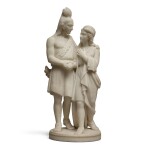
Edmonia Lewis
Hiawatha’s Marriage
Auction Closed
January 19, 07:25 PM GMT
Estimate
250,000 - 350,000 USD
Lot Details
Description
Edmonia Lewis
1844 - 1907
Hiawatha's Marriage
signed Edmonia. Lewis and dated Roma 1870 (along the base); titled Hiawatha's Marriage. (along the base)
marble
height: 27 ¼ in. (69.2 cm.)
Conceived in 1866; this example executed in 1870.
Adalberto and Annamaria Vinciguerra, Italy
Private Collection, Italy (by descent from the above)
Acquired from the above circa 2000 by the present owner
Wayne Craven, Sculpture in America, New York 1968, p. 334, another example mentioned
William H. Gerdts, American Neo-Classic Sculpture, New York 1973, p. 133, another example mentioned
Kirsten Pai Buick, Child of the Fire : Mary Edmonia Lewis and the Problem of Art History's Black and Indian Subject, North Carolina 2010, pp. 124-8, fig. 21, illustration of another example
Kirsten Pai Buick, "The Ideal Works of Edmonia Lewis: Invoking and Inverting Autobiography," American Art, Summer 1995, pp. 5-19, illustration of another example p. 17
Rinna Evelyn Wolfe, Edmonia Lewis : Wildfire in Marble, New Jersey 1998, p. 74, illustration of another example
A woman of mixed African-American and Native American heritage (Mississauga Ojibwe), Edmonia Lewis experienced a difficult childhood in Newark, New Jersey, with both of her parents passing away before she turned nine. Along with her older half-brother brother Samuel, Lewis moved to the Niagara Falls area to be raised by maternal aunts. In pursuit of wealth, her brother moved West to participate in the California Gold Rush, where he became rich, and thereafter supported Lewis’ endeavors. In 1859, she enrolled at Ohio's Oberlin College financed by his generosity, although she was unable to complete her degree. Exactly the reason for her dismissal during her final term remains unclear, but she faced racism at the progressive institution. Supported by her half-brother, she relocated to Boston where she began to practice art in the early 1860s. As she was unable to afford her peers’ artistic training, grounded in the study of the nude body, the sculptor Edward Augustus Brackett took Lewis under his wing and helped her set up a studio. Reportedly, Lewis was comforted by Brackett’s 1859-60 bust of the abolitionist John Brown, remarking that “the man who made a brist of John Brown must be a friend to my people” (quoted in William Loren Katz, The Black West, New York 2005, p. 11). Although Lewis trained under Brackett by translating his busts into portrait medallions, the partnership broke off unceremoniously by 1865 when she left for Europe.
Hiawatha's Marriage stems from Lewis’ time in Europe, where she remained for the rest of her life aside from trips to the United States to sell and exhibit her works. In Rome, where she maintained a studio for the most successful part of her career, Lewis was able to practice sculpture largely free from the racism she had experienced in the United States. Nevertheless, she still experienced sexism and thus dedicated herself to enlarging her models in marble herself, rather than by hiring Italian assistants, which would have supported claims that women could not work independently. The present work relates to Lewis’ intersectional identity, inspired by Henry Wadsworth Longfellow’s fictional poem The Song of Hiawatha. Longfellow based the epic on a legendary Ojibwe figure, Manabozho, while taking the name Hiawatha from an Onandaga leader. Upon its publication, Hiawatha was soundly criticized, although it became extremely popular as an early version of the ideal of the Native American as the “noble savage,” selling an estimated 50,000 copies in the two years after its 1855 publication. Lewis depicts a section of the poem describing Hiawatha’s marriage to Minnehaha, who came from a different tribe. A selection from part X of Longfellow’s poem provides the context:
“In the land of the Ojibways,
In the pleasant land and peaceful.
"After many years of warfare,
Many years of strife and bloodshed,
There is peace between the Ojibways
And the tribe of the Dacotahs."
Thus continued Hiawatha,
And then added, speaking slowly,
"That this peace may last forever,
And our hands be clasped more closely,
And our hearts be more united,
Give me as my wife this maiden,
Minnehaha, Laughing Water,
Loveliest of Dacotah women!"”
